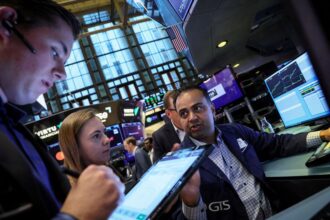Since the publication of Megathreats in October 2022, the themes I emphasized have gone mainstream. Everyone now acknowledges that economic, monetary and financial threats are rising and interacting in dangerous ways with various other social, political, geopolitical, environmental, health and technological developments.
Hence, in December 2022, the Financial Times chose “polycrisis” as one of its buzzwords of the year. Whatever one’s preferred term (others have adopted “permacrisis” or “confluence of calamities”), there is growing recognition that not only the global economy but also human survival is at risk.
As I warned in Megathreats, the “Great Moderation” (a long period of low macroeconomic volatility following the mid-1980s) has given way to the “Great Stagflation.” In 2022, we witnessed a surge of inflation in advanced economies and emerging markets, a sharp slowdown of global growth that continued into 2023, and signs of severe private- and public-sector debt problems as central banks raised policy rates to stabilize prices.
Owing to this monetary-policy tightening, inflation has fallen around the world; moreover, the impact of stagflationary short-term negative supply shocks — the pandemic, the commodity-price spike following Russia’s invasion of Ukraine, and China’s “zero-COVID” policy — has been gradually fading throughout 2023. But inflation remains well above the 2% target in advanced economies, and a dozen other medium-term negative aggregate supply shocks discussed in Megathreats have grown more severe.
For example, de-globalization has continued, with more countries shifting from free trade to secure trade, and from economic integration to decoupling and “de-risking.” Reshoring, near-shoring, and “friend-shoring” imply a tradeoff between efficiency and resilience, with just-in-time global supply chains being replaced by “just-in-case” arrangements.
Moreover, societal aging in Europe, Japan, and China is reducing the supply of workers at a time when immigration restrictions are hampering the flow of labor from poor to rich countries — all of which increases labor costs. Climate change is already fueling energy and food insecurity, increasing energy and food costs, and the world still has not done nearly enough to prepare for future pandemics.
“The simmering backlash against rising wealth inequality may lead to more wage-increasing fiscal policies and support for populist politicians.”
Then there are the new, under-appreciated risks posed by AI-enhanced cyber-warfare and disinformation, as well as longstanding problems such as the simmering backlash against rising wealth inequality (which may lead to more wage-increasing fiscal policies and support for populist politicians). Finally, as the United States leans more heavily on the U.S. dollar
DX00,
as a foreign-policy tool, de-dollarization remains an acute risk.
Thus, despite the short-term moderation of COVID-related shocks, the world still faces major stagflationary risks (lower growth and higher inflation), most of which are likely to become stronger over the next decade.
The party is over
I also previously warned that high- and rising private- and public debt ratios, which reached 330% of GDP globally in 2022 (420% in advanced economies and more than 300% in China), mark a dramatic shift from the pre-2021 period, when debt ratios were high but debt-service ratios were low. The decade of secular stagnation after the Global Financial Crisis was characterized by low aggregate-demand growth, large private- and public savings, and low investment rates. Slow growth led to low inflation-adjusted interest rates, while near-zero or even negative policy rates, combined with quantitative and credit easing, kept nominal and real rates very low — and often negative — both on the short- and long end of the yield curve.
“Central banks are caught in a ‘debt trap.’ ”
But that easy-money environment is gone. The negative supply shocks of the COVID pandemic, together with the stimulus policies in response to it, led to a surge of inflation starting in 2021. Central banks then reacted (eventually) by hiking both nominal and real rates. But with private and public debt ratios so high, central banks will find it difficult to reduce inflation to their 2% target. They are caught in a “debt trap,” facing not only a dilemma — how to achieve 2% inflation without causing an economic hard landing — but a “trilemma”: how to achieve price stability while also avoiding a recession and a financial crisis.
Developments since the publication of Megathreats have confirmed that this trilemma is a serious issue. If central banks continue increasing policy rates to pull inflation down to 2%, a recession and debt distress among highly leveraged private and public borrowers become more likely. But if policymakers blink and give up on their price-stability goal, inflation and inflation expectations could become de-anchored, triggering a wage-price spiral.
So far, central banks have not blinked. But if inflation remains above target, as seems likely given high wage growth and still-high commodity prices, they eventually may bend to avoid causing an economic downturn and a financial crash. The fact that they have already paused rate hikes despite too-high core inflation (which excludes volatile food and energy prices) suggests that they may be preparing to accept above-target inflation.
Wars of necessity
On top of the negative aggregate supply shocks, various aggregate demand trends also imply that inflation will be higher. As deficits grow, central banks eventually may be forced to monetize public debt. Deficits will grow because many key countries are engaged in at least six battles (including some real wars) that will require larger levels of spending.
“Higher levels of spending on conventional and unconventional weapons (including nuclear, cyber, bio, and chemical) are all but assured.”
For starters, we are now in a “geopolitical depression,” owing to the intensifying rivalry between the West and (tacitly allied) revisionist powers such as China, Russia, Iran, North Korea and Pakistan. Russia’s invasion of Ukraine could still expand and drag in NATO. Israel (and possibly the U.S.) is on a collision course with Iran, which is at the threshold of becoming a nuclear-weapon state. Israel’s military operation in Gaza in response to Hamas’s massacre of Israeli civilians on October 7 risks fanning the flames of a broader regional conflict, which would cause another spike in energy prices.
Meanwhile, the U.S. and China continue to square off over influence in Asia and the fate of Taiwan. With the U.S., Europe, NATO, and pretty much everyone across the Middle East and Asia re-arming, higher levels of spending on conventional and unconventional weapons (including nuclear, cyber, bio, and chemical) are all but assured.
Climate and health at risk
The battle against climate change will also be expensive. The cost of mitigation and adaptation is expected to be trillions of dollars per year for decades to come, and it is naive to think that these investments will all boost growth. Consider a real war that destroys much of a country’s physical capital. Though a surge of investment in reconstruction can produce an economic expansion, the country is still poorer for having lost a large share of its wealth. The same is true of climate investments. A significant share of the existing capital stock will have to be replaced, either because it has become obsolete or because it has been destroyed by climate-driven events.
“Disease outbreaks with the potential to become pandemics will become more frequent.”
There is also a costly battle to wage against future pandemics. For a variety of reasons — some of them related to climate change — disease outbreaks with the potential to become pandemics will become more frequent. Whether countries invest in prevention or deal with future health crises after the fact, higher costs on a perpetual basis will add to the growing burden associated with societal aging and pay-as-you-go health-care systems and pension plans. Already, these unfunded implicit liabilities are estimated to be above the level of explicit public debt for most advanced economies.
We can also expect a war-like mobilization to deal with the disruptive effects of “globotics”: the combination of globalization and automation that is threatening a growing number of blue- and white-collar occupations, including creative and managerial jobs. Governments will be under growing pressure to help those left behind, whether through basic-income schemes, higher fiscal transfers, or expanded public services. These costs will remain large even if automation leads to a surge in economic growth. For example, it would cost the U.S. 20% of GDP just to support a meager universal basic income (UBI) of $1,000 per month.
Then there is the related fight against rising income and wealth inequality. This battle is becoming increasingly urgent, now that the malaise afflicting young people and many middle- and working-class households is fueling a backlash against liberal democracy and free-market capitalism. To prevent populist regimes from coming to power and pursuing reckless, unsustainable economic policies, liberal democracies will need to spend heavily to reinforce their social safety nets — as many are already doing.
Finally, managing societal aging will require Herculean efforts. Pay-as-you-go health-care and pension systems will add to explicit public debt (which has already reached a level of 112% of GDP, on average, across advanced economies) an implicit debt that is often larger.
These battles are necessary, but they will be expensive, and economic and political constraints will limit governments’ ability to finance them with higher taxes. Tax-to-GDP ratios are already high in most advanced economies, especially Europe, and tax evasion, avoidance, and arbitrage will further complicate efforts to increase taxes on high incomes and capital (assuming such measures could even get past the lobbyists or gain support from center-right parties).
Tax and spend
Higher government spending and transfers, without a commensurate increase in tax revenues, will cause structural budget deficits to grow even larger than they already are, potentially leading to unsustainable debt ratios that will increase borrowing costs and culminate in debt crises – with obvious adverse effects on economic growth. Of course, under these conditions, many emerging-market and developing countries with foreign currency-denominated debt will need to default or undergo coercive restructurings. But for countries that borrow in their own currencies, the expedient option will be to allow higher inflation as a means of eroding the real value of long-term fixed-rate nominal debt.
This approach, which functions as a tax on savers and creditors and a subsidy for borrowers and debtors, can then be combined with other draconian measures such as financial repression or taxes on capital. Since many of these measures do not require explicit legislative or executive approval, they inevitably become the path of least resistance when deficits and debts are unsustainable.
“Already, bond markets have started to signal concerns about unsustainable fiscal deficits and public debts.”
Already, bond markets have started to signal concerns about unsustainable fiscal deficits and public debts, not just in poor countries and emerging markets but also in advanced economies. A sharp rise in long-term bond rates in both Europe and the U.S. indicates that demand for bonds is shrinking as supply rises with growing budget deficits, central banks move from QE to QT (quantitative tightening), investors seek higher risk premiums, and U.S. rivals gradually reduce their dollar reserves.
Moreover, there will likely be even more upward pressure on long-term rates in the U.S. and other G10 countries when Japan starts to normalize monetary policy and abandons the yield-curve-control policy that it has used to keep long-term rates close to 0%.
It is not just nominal bond yields that are rising; so are real yields. During the decade of secular stagnation, real long-term yields were close to zero or negative, owing to high savings and low investment rates. But we are entering an era of negative public savings (growing fiscal deficits), lower private savings (driven by aging and lower income growth), and higher investment rates (owing to climate change mitigation and adaptation, infrastructure spending, and AI).
Thus, real rates are positive, and they are being pushed higher by higher risk-premia on public bonds as debts surge. Some investment banks now estimate that the equilibrium long-term rate is close to 2.5%, while recent academic research puts it closer to 2%. In any case, the nominal and real cost of capital will be much higher in the future.
“The new de facto (though not official) inflation target over the next decade may hew closer toward 4-5%.”
Given the aggregate supply and demand factors driving inflation higher, the new de facto (though not official) inflation target over the next decade may hew closer toward 4-5%. But accepting a higher inflation rate may de-anchor inflation expectations — as happened in the 1970s — with serious consequences for economic growth and returns on financial assets.
Life after the ‘everything bubble’
Until 2021, monetary, fiscal, and credit easing inflated the valuations of just about everything: U.S. and global equities, real estate, and government and corporate bonds; tech, growth, and venture firms, and speculative assets including cryptocurrencies, meme stocks, and SPACs (special purpose acquisition companies). When this “everything bubble” burst in 2022, speculative assets — starting with VC, crypto, and meme stocks — lost much more value than traditional stocks.
But safe assets such as government bonds also lost money as higher long-term interest rates brought bond prices down. For example, the rise in bond yields in the U.S. from 1% to 3.5% in 2022 implied that 10-year Treasury bonds
BX:TMUBMUSD10Y
lost more in price (-20%) than the S&P 500
SPX
(-18%). This year brought additional losses on long-duration bonds (around -15% in price terms) as bond yields surged further toward 5%. Traditional asset-allocation models that balance equities against bonds thus lost on both fronts.
“ If bond yields rise from their current 4.5% to 7.5%, that will cause a crash in both bond prices (by 30%) and equities.”
This bloodbath is likely to continue. With average inflation running 5%, rather than 2%, long-term bond yields would need to be closer to 7.5% (5% for inflation and 2.5% for a real return). But if bond yields rise from their current 4.5% to 7.5%, that will cause a crash in both bond prices (by 30%) and equities (with a serious bear market), because the discount factor for dividends will be much higher. Globally, losses for bondholders and equity investors alike could grow into the tens of trillions of dollars over the next decade.
To be sure, U.S. and global equities did rally through the middle of 2023, following the 2022 bear market. But most of this was driven by a small group of Big Tech stocks that benefited from the hope and hype around generative AI. If one excludes these high-flyers, markets were almost flat.
Moreover, for most of 2023, investors were engaged in wishful thinking about central banks declaring an end to the rate-hiking cycle, with many even betting on rate cuts in the near-future. But persistent inflation dashed these hopes, leading central banks to adopt a policy of “higher for longer,” which is likely to lead to an economic contraction and additional financial stress. This past summer and fall, U.S. bond yields surged from 3.7% toward 5%, alongside another significant correction of U.S. and global equities.
As far as growth is concerned, both the Eurozone and the United Kingdom are already in a stagflationary near-recession, and China is mired in a structural slowdown. While the U.S. has avoided a recession, it may yet end up in a short and shallow one if the Federal Reserve’s “higher for longer” policy causes elevated bond yields to persist.
“All recent evidence suggests that the ‘geopolitical depression’ is getting worse: ”
In any case, the risk of a bear market in equities is more secular than cyclical. If any number of megathreats materialize over the next decade, their stagflationary impact will undercut equities over the medium term.
All recent evidence suggests that the “geopolitical depression” is getting worse: Russia’s invasion of Ukraine has evolved into a war of attrition, with the Ukrainians mounting a grueling counter-offensive to reclaim territory lost in 2022. The war could easily intensify, pull in other parties, such as NATO, or escalate with the use of unconventional weapons. Such scenarios, of course, would bring further spikes in energy and commodity prices.
In the Middle East, Iran is poised to make the final step from uranium enrichment to building a nuclear weapon. This confronts Israel with a fateful choice: either accept a nuclear-armed Iran and hope that traditional deterrence works, or launch a military strike, which would cause a sharp spike in oil prices (among other things), potentially tipping the global economy into a stagflationary downturn. The conflict between Israel and Hamas over Gaza could well escalate into a regional one involving Iran and its Lebanese proxy Hezbollah.
In Asia, the cold war between the U.S. and China is getting colder and could potentially turn hot if China decides to reunite Taiwan with the mainland by force. And while the world’s attention is focused on Ukraine, Taiwan and Gaza, North Korea is becoming more aggressive with its missile launches over the waters around South Korea and Japan.
Of these risks, the biggest is an escalation of the Sino-American cold war. Following the May 2023 G7 summit in Hiroshima, Japan, U.S. President Joe Biden claimed that he expected a “thaw” with China. Yet, despite some official bilateral meetings, relations remain icy. In fact, the G7 summit itself confirmed Chinese fears about the U.S. pursuing a strategy of “comprehensive containment, encirclement, and suppression.”
Unlike previous gatherings, when G7 leaders offered mostly talk and little action, the Hiroshima summit may well have been the most important in the group’s history. The recent summit in San Francisco between Chinese President Xi Jinping and Biden did not change anything structural in the collision between U.S. and China. Despite a short-term partial détente, the cold war is becoming colder, and may eventually become hot over the issue of Taiwan.
“The Sino-Russian friendship “without limits” is having serious consequences for how other powers perceive China.”
After all, the U.S., Japan, Europe, and their friends and allies made it clearer than ever that they intend to join forces to counter China. Japan, as the host, was sure to invite key Global South leaders whom it wants to enlist in containing China’s rise. Chief among these was Indian Prime Minister Narendra Modi. While India (which held the G20 presidency in 2023) has taken a neutral position on Russia’s war in Ukraine, it has long been locked in a strategic rivalry with China, owing partly to the two countries’ long shared border, sections of which remain disputed.
Even if India does not become a formal ally to Western countries, it will continue to position itself as an independent, rising power whose interests are more aligned with the West than with China and its de facto allies (Russia, Iran, North Korea, and Pakistan). Moreover, India is a formal member of the Quadrilateral Security Dialogue (the Quad) with the U.S., Japan, and Australia, the explicit purpose of which is to deter China. Japan and India have longstanding friendly relations and a shared history of adversarial relations with China.
Japan also invited Indonesia, South Korea (with which it is pursuing a diplomatic thaw, driven by common concerns about China), Brazil (another key Global South power), and Ukrainian President Volodymyr Zelensky to the G7. In each case, the message was clear: The Sino-Russian friendship “without limits” is having serious consequences for how other powers perceive China.
In its final communiqué, the G7 explained at length how it will confront and deter China in the years ahead. It decried Chinese “economic coercion” and expansionism in the East and South China Seas, stressed the importance of an Indo-Pacific partnership, and issued a clear warning to China not to attack or invade Taiwan.
In taking steps to “de-risk” their relationships with China, Western leaders settled on language that is only slightly less aggressive than “de-coupling.” But it isn’t just the diplomatic argot that has changed. According to the communiqué, Western containment efforts will be accompanied by large investments in clean energy and infrastructure across the Global South, lest key middle powers be drawn into China’s sphere of influence through its Belt and Road Initiative.
Meanwhile, the Western-Chinese tech and economic war continues to escalate. Japan recently imposed restrictions on semiconductor exports to China that are no less draconian than those introduced by the U.S., and the Biden administration has since pressured Taiwan and South Korea to follow suit. In response, China has banned semiconductors made by the U.S.-based chipmaker Micron Technology
MU,
and has begun to restrict exports of some critical metals over which it has a near-monopoly in production and refining.
Likewise, U.S. chipmaker Nvidia
NVDA,
— which is quickly becoming a corporate superpower, owing to surging demand for its advanced chips to power AI applications — is facing new constraints on selling to China. U.S. policymakers have made clear that they intend to keep China at least a generation behind in the race for AI supremacy. To that end, the U.S. CHIPS and Science Act of 2022 introduced massive incentives to re-shore chip production.
The risk now is that China will leverage its dominant role in producing and refining rare-earth metals that are key inputs in the green transition. China has already increased its exports of electric vehicles by about 700% in value terms since 2017, and it is starting to deploy commercial airliners that eventually could compete with Boeing
BA,
and Airbus
AIR,
So, while the G7 wants to deter China without escalating the cold war, the response from Beijing suggests that it has failed to thread the needle.
“The U.S. and China cold war will mean more fragmentation of the global economy. ”
Of course, the Chinese would like to forget that their own aggressive policies contributed to the situation. In interviews marking his 100th birthday in May, Henry Kissinger — the architect of America’s “opening to China” in 1972 — warned that unless the U.S. and China find a new strategic understanding, they will remain on a collision course that could end in outright war. The deeper the freeze, the greater the risk of a violent crack-up and military hostilities this decade.
Even without an actual hot war between the U.S. and China, a colder war will mean more fragmentation of the global economy, more balkanization of global supply chains, more de-risking or decoupling, and more restrictions on cross-border flows of goods, services, capital, people, data, and knowledge. Neoliberal free trade is out; industrial policies, “homeland economics,” subsidies, and secure trade are in, as the world increasingly divides into two economic, monetary, financial, currency, trade, investment, and technological domains.
Climate risks are climbing
At the same time, the costs of climate change will continue to increase rapidly. Scientists now expect global average temperatures to reach 1.5° Celsius above pre-industrial levels — the Paris climate agreement target — in the next five years. To hold temperature increases there, greenhouse-gas emissions would have to be cut by half by 2030, which is basically impossible. Even if all the commitments made at COP26 in Glasgow and COP27 in Sharm El-Sheikh were to be met — a very big if — temperatures would still be on track to hit 2.4°C above pre-industrial levels by the end of this century.
“Humanity’s handling of climate change amounts to a slow-motion, but accelerating, train wreck.”
In the absence of real action, greenwashing, greenwishing and greenflation have become rampant. The good news is that there are many technological options that can accelerate decarbonization and help us achieve net-zero emissions with limited impact on economic growth: renewable energy, carbon capture and storage, clean and green hydrogen, and nuclear fusion.
The bad news is that fusion is still a long way from commercialization, and many of the other options remain costly compared to fossil fuels. Humanity’s handling of climate change amounts to a slow-motion, but accelerating, train wreck.
Making matters worse, poorer emerging markets and developing countries are facing dire economic prospects. After an anemic recovery from the COVID pandemic, they bore the brunt of higher food and energy prices following Russia’s invasion of Ukraine. Higher inflation has eroded real incomes, and their currencies have weakened against the U.S. dollar
DX00,
This, combined with higher interest rates, has left many nations with unsustainable debts. The International Monetary Fund and the World Bank estimate that about 60% of poor countries and 25% of emerging markets cannot service their debts and will need to restructure them.
Social strife, political instability and AI’s rise
Against this backdrop, increased poverty, climate change, inequality, and social strife could easily lead to domestic political instability or even failed states, causing mass migration and fueling the trend toward economic populism. Most of Latin America is now ruled by left-wing populists, while far-right authoritarian populism is on the rise in other parts of the world.
In the U.S., former president Donald Trump is the clear favorite to win the Republican Party’s nomination for the 2024 presidential election, and could well retake the White House. In the U.K., the demagogic Boris Johnson remains very popular. A party with fascist roots is running Italy, and the far-right Marine Le Pen remains the de facto opposition leader in France. In Turkey, the recently re-elected President Recep Tayyip Erdoğan continues to consolidate autocratic rule. Until the Hamas attack, Israel was governed by the most right-wing coalition in its history. And, of course, Russian President Vladimir Putin and China’s Xi have formed a new authoritarian axis.
Finally, in the year since Megathreats appeared, AI has become an even bigger topic, owing to the public release of generative AI platforms like ChatGPT. I had originally predicted that deep-learning architectures (“transformer networks”) would revolutionize AI, and that does seem to be what has happened. The potential benefits — and pitfalls — of generative AI are profound, and they are becoming increasingly clear. On the positive side, productivity growth could be sharply increased, vastly enlarging the economic pie; but, as was true of the first digital revolution and the creation of the internet and its applications, it will take time for such gains to emerge and achieve scale.
The risks associated with AI are also becoming clear. Many worry about permanent technological unemployment, not just among low-skilled blue-collar workers, but also across creative professions. In an extreme scenario, the economy two decades from now could be growing at a rate of 10% per year, but with unemployment at 80%. A related risk, then, is that AI will be another winner-takes-all industry that turbocharges income and wealth inequality.
AI also will have a similar effect on disinformation, including through “deep fake” videos, and various forms of cyber-warfare, especially around elections. And, of course, there is the small but terrible risk that advances in AI will lead to AGI (artificial general intelligence) and the obsolescence of the human species.
The debate over whether tech firms should be regulated more strictly, or even broken up, continues to intensify. But the obvious counter-argument is that America needs Big Tech and AI firms to assure its dominance over China, which is doing everything it can to become a military superpower.
Fortunately, if AI does usher in a world of 10% annual growth, a UBI or substantially more income redistribution could well be possible. Moreover, AI also could help us address other megathreats such as climate change and future pandemics. While none of these positive outcomes can be taken for granted, given the power and influence that elites wield, problems of distribution are always easier to tackle in a high-growth setting than in a low-growth one.
While stagflationary forces will weigh on growth and exacerbate megathreats in the medium term, the future could be bright if we can avert a dystopian scenario in which megathreats destructively feed on each other. Our first priority will be to survive the next few decades of instability and chaos.
Nouriel Roubini is professor emeritus of economics at New York University’s Stern School of Business and chief economist and co-founder of Atlas Capital Team. The paperback edition of his book Megathreats: Ten Dangerous Trends That Imperil Our Future, and How to Survive Them (Little, Brown and Company, 2022) was published this month.
This commentary was published with the permission of Project Syndicate — Our Megathreatened Age
More: The ‘great inflation surge’ will end in 2024 and rates will fall nearly everywhere, says Capital Economics
Also read: The U.S. must become less dependent on China for trade. Here’s what the Biden administration should do now.
Read the full article here








